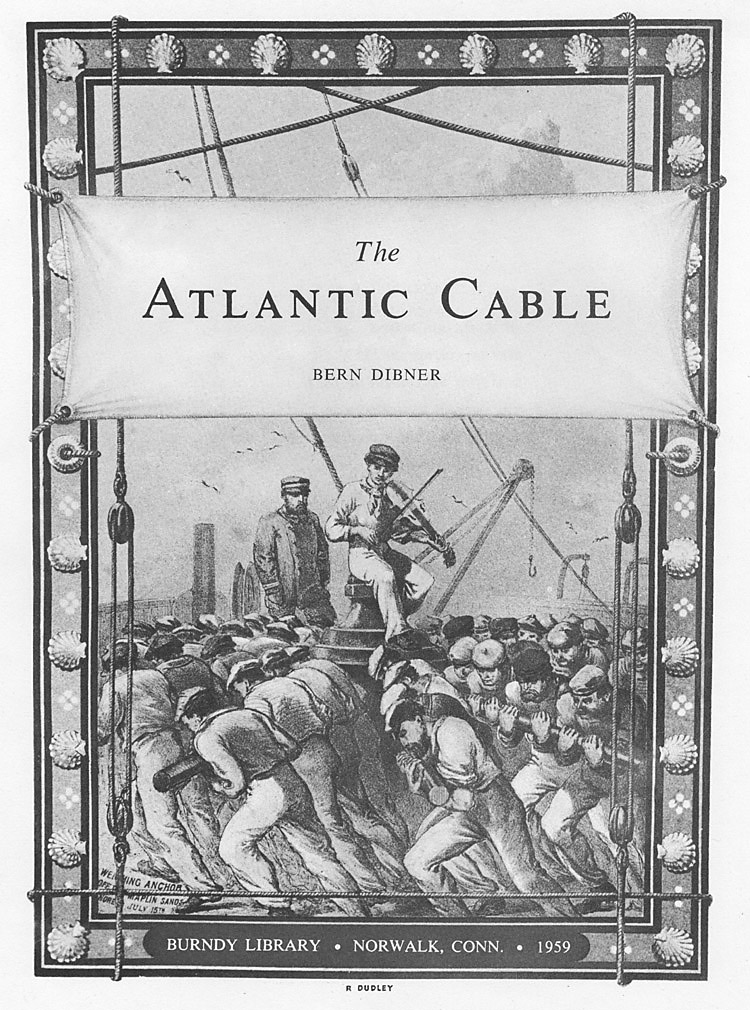Bern Dibner: The Atlantic Cable (1959)
Filed under book | Tags: · history of science, history of technology, science, technology, telegraphy

“Bern Dibner wrote a lucid chronological history of the laying of the Atlantic Cable. He covers the early experiments of Morse in New York Harbor in 1842; Ezra Cornell’s laying of a line across the Hudson River in 1845; the five actual attempts at laying the cable; and the eventual success in completing two telegraph circuits connecting Newfoundland and Ireland in 1866.
Cyrus Field was, in the words of William Thomson (later Lord Kelvin), the “originator and mainspring” of the project, which was regarded as foolhardy in many quarters. At the outset in 1854, Field realized that many electrical, mechanical, oceanographical, and nautical problems would have to be solved. Having sought and obtained encouragement of specialists in each of these areas, he was able to raise the necessary capital to finance the design, manufacture, transportation, and laying of the submarine telegraph cable. Field did not foresee, however, that the enterprise would take twelve years and forty long, hazardous trans-Atlantic crossings (the first by sailing vessel); that it woudl touch the fields of science, politics, finance, and geography; and that it would cost $12,000,000.
This book makes clear the roles of Field and Morse and Thomson, of the ships’ captains and the financial backers, and of all those who played a part in the courageous undertaking.” (source)
Publisher Burndy Library, Norwalk/Connecticut, 1959
96 pages
via Smithsonian Libraries
Videos about the transatlantic telegraph cable (via Marcell Mars):
The Great Transatlantic Cable (PBS, 120 min), torrent
Modern Marvels S01E06 – Transatlantic Cable (44 min)
History Detectives – Transatlantic Cable (PBS, 16 min)
PDF (no OCR)
Comment (0)Finn Brunton: Spam: Shadow History of the Internet (2013)
Filed under book | Tags: · arpanet, botnet, captcha, history of technology, internet, malware, spam, technology, usenet

The vast majority of all email sent every day is spam, a variety of idiosyncratically spelled requests to provide account information, invitations to spend money on dubious products, and pleas to send cash overseas. Most of it is caught by filters before ever reaching an in-box. Where does it come from? As Finn Brunton explains in Spam, it is produced and shaped by many different populations around the world: programmers, con artists, bots and their botmasters, pharmaceutical merchants, marketers, identity thieves, crooked bankers and their victims, cops, lawyers, network security professionals, vigilantes, and hackers. Every time we go online, we participate in the system of spam, with choices, refusals, and purchases the consequences of which we may not understand.
This is a book about what spam is, how it works, and what it means. Brunton provides a cultural history that stretches from pranks on early computer networks to the construction of a global criminal infrastructure. The history of spam, Brunton shows us, is a shadow history of the Internet itself, with spam emerging as the mirror image of the online communities it targets. Brunton traces spam through three epochs: the 1970s to 1995, and the early, noncommercial computer networks that became the Internet; 1995 to 2003, with the dot-com boom, the rise of spam’s entrepreneurs, and the first efforts at regulating spam; and 2003 to the present, with the war of algorithms—spam versus anti-spam. Spam shows us how technologies, from email to search engines, are transformed by unintended consequences and adaptations, and how online communities develop and invent governance for themselves.
Publisher MIT Press, 2013
Infrastructures Series
ISBN 026201887X, 9780262018876
270 pages
review (Evgeny Morozov, The Wall Street Journal)
interview with author (NPR)
Download (removed on 2013-5-20 upon request of the publisher)
Comment (0)Jon Gernter: The Idea Factory: Bell Labs and the Great Age of American Innovation (2012)
Filed under book | Tags: · communication technology, computing, engineering, history of communications, history of computing, history of technology, networks, radio, technology, telephone

“High-handed corporate monopoly and high-minded national treasure, the American Telephone and Telegraph Company (AT&T) was a unique project of America’s pragmatism and for decades the envy of the world in extending low-cost local telephone service. At the heart of AT&T was its R&D unit, Bell Laboratories, the world’s greatest entity of its kind, and a giant manufacturing arm, Western Electric.
The Idea Factory is the first study of Bell Labs that puts its history in its full organizational, political, and administrative context. AT&T was a company striving to expand and maintain a privileged empire under a government that saw it alternatively as a trusted military/industrial partner and an anticompetitive threat. This ambiguous embrace, New York Times Magazine writer Jon Gertner suggests, inadvertently encouraged a culture that combined a gifted and diverse workforce with a long-term outlook, creating the foundations of a new information economy, which in turn made radical changes in the charter of the parent company inevitable.
Gertner’s story is the interaction between three leaders of Bell Labs in its critical years—Mervin Kelly, Jim Fisk, and William Oliver Baker—and three of its greatest scientific minds: William Shockley, Claude Shannon, and John Pierce.” (from a review by Edward Tenner)
Publisher The Penguin Press, New York, 2012
ISBN 1594203288, 9781594203282
422 pages
via Steve McLaughlin
review (Edward Tenner, Issues in Science and Technology)
review (Dave Tompkins, Slate)
review (Jesse Hicks, The Verge)
PDF (EPUB, updated on 2013-5-7)
PDF (MOBI, updated on 2013-5-7)

